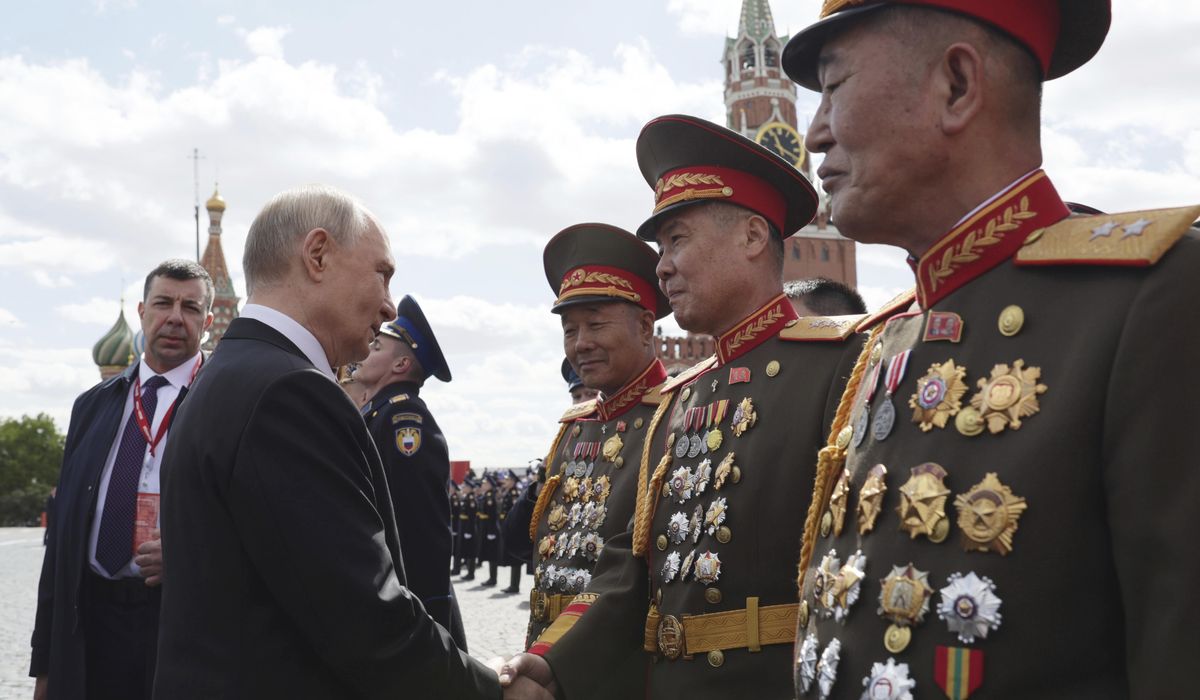


SEOUL, South Korea — In the latest sign of closer ties between Moscow and Pyongyang, North Korea will deploy construction battalions and mine-clearance troops to Russia’s heavily damaged Kursk region, it was reported Tuesday.
With combat over in Kursk Oblast, speculation was rife as to whether North Korea would shift to a combat role in Ukraine proper or take on a different role.
Tuesday’s news suggests the latter.
Russian State Security Council Secretary Sergei Shoigu, a former defense minister and a close confidante of President Vladimir Putin, was received in Pyongyang Tuesday by North Korean leader Kim Jong-un, per Russian news agency TASS.
It was Mr. Shoigu’s third such visit in three months and comes one day ahead of the first anniversary of the signing of a bilateral Comprehensive Strategic Partnership treaty by Mr. Kim and Mr. Putin.
The agreement stunned North Korean watchers: It offered Mr. Kim a pathway out of decades of isolationism and stagnation that followed the fall of the Soviet Union. It lessened his unilateral reliance upon China and reduced his need to improve relations with South Korea and the United States.
Mr. Shoigu praised expanding rail ties between the two countries on Tuesday and said he hoped for the resumption of direct flights for the first time in 30 years.
But his “main focus,” he told TASS, was “security issues.”
He said Pyongyang had agreed to deploy “1,000 sappers to clear mines on Russian territory,” and “5,000 military builders to restore infrastructure destroyed by the occupiers.”
Deployment of non-combat troops makes sense, given the use Pyongyang puts its regular army to.
Outside the ranks of crack combat units, regular North Korean troops spend much of their service undertaking construction and agricultural projects as a form of state labor.
Mr. Shoigu also spoke of raising monuments to the dead.
“The heads of our states have decided to perpetuate the feat of the soldiers of the Korean People’s Army who took part in the fighting,” he said. “Specifically, we are talking about the unveiling of memorials in Russia and [North Korea] in memory of the Korean soldiers who fell in the battles for the liberation of the Russian territory.”
On Aug. 5, 2024, Ukrainian troops stormed into Russia’s Kursk region. Moscow was caught on the back foot, and Kiev’s forces were able to occupy hundreds of square miles of Russia.
Pushback was slow and bloody.
In October, North Korean formations, believed to be from the 200,000-strong elite arm of Mr. Kim’s million strong armed forces, entered the field.
Inexperienced and unable to interoperate effectively with Russian troops, they suffered heavy losses in early engagements. However, they impressed Ukrainian soldiers with their fitness, marksmanship, cohesion and willingness to fight to the death, and adapted quickly to the modern battlefield.
By March, Russia had recaptured Kursk. North Korea is believed to have deployed up to 13,000 men.
According to the U.K. Ministry of Defense, their casualties may have reached 6,000.
The deployment apparently took place under the provisions of Article 4 of the 2024 treaty, which calls for “military and other assistance” in the case of “armed invasion” of national territory. That article may not support the deployment of North Korean soldiers onto Ukrainian terrain.
North Korea’s operations “have thus far been confined to the Kursk region,” London’s MOD wrote. “Any decision to deploy into internationally recognized, sovereign Ukrainian territory in support of Russian forces would almost certainly require” sign-off from Mr. Putin and Mr Kim.
Analysts are hustling to discover how Russia is repaying North Korea for its shed blood, and for the millions of munitions and rockets it has sent.
Indications from Ukraine are that North Korean tactical ballistic missiles are gaining significantly improved accuracy, possibly from Russian assistance with guidance systems.
Russian-style air defense systems have been spotted on new North Korean destroyers and some reports state that Russia is sharing Iranian drone technology with Pyongyang.
• Andrew Salmon can be reached at asalmon@washingtontimes.com.
